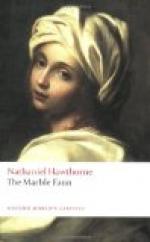Here, then, was a treasure for the sculptor to have found! How happened it to be lying there, beside its grave of twenty centuries? Why were not the tidings of its discovery already noised abroad? The world was richer than yesterday, by something far more precious than gold. Forgotten beauty had come back, as beautiful as ever; a goddess had risen from her long slumber, and was a goddess still. Another cabinet in the Vatican was destined to shine as lustrously as that of the Apollo Belvedere; or, if the aged pope should resign his claim, an emperor would woo this tender marble, and win her as proudly as an imperial bride!
Such were the thoughts with which Kenyon exaggerated to himself the importance of the newly discovered statue, and strove to feel at least a portion of the interest which this event would have inspired in him a little while before. But, in reality, he found it difficult to fix his mind upon the subject. He could hardly, we fear, be reckoned a consummate artist, because there was something dearer to him than his art; and, by the greater strength of a human affection, the divine statue seemed to fall asunder again, and become only a heap of worthless fragments.
While the sculptor sat listlessly gazing at it, there was a sound of small hoofs, clumsily galloping on the Campagna; and soon his frisky acquaintance, the buffalo-calf, came and peeped over the edge of the excavation. Almost at the same moment he heard voices, which approached nearer and nearer; a man’s voice, and a feminine one, talking the musical tongue of Italy. Besides the hairy visage of his four footed friend, Kenyon now saw the figures of a peasant and a contadina, making gestures of salutation to him, on the opposite verge of the hollow space.
CHAPTER XLVII
THE PEASANT AND CONTADINA
They descended into the excavation: a young peasant, in the short blue jacket, the small-clothes buttoned at the knee, and buckled shoes, that compose one of the ugliest dresses ever worn by man, except the wearer’s form have a grace which any garb, or the nudity of an antique statue, would equally set off; and, hand in hand with him, a village girl, in one of those brilliant costumes largely kindled up with scarlet, and decorated with gold embroidery, in which the contadinas array themselves on feast-days. But Kenyon was not deceived; he had recognized the voices of his friends, indeed, even before their disguised figures came between him and the sunlight. Donatello was the peasant; the contadina, with the airy smile, half mirthful, though it shone out of melancholy eyes,—was Miriam.
They both greeted the sculptor with a familiar kindness which reminded him of the days when Hilda and they and he had lived so happily together, before the mysterious adventure of the catacomb. What a succession of sinister events had followed one spectral figure out of that gloomy labyrinth.




